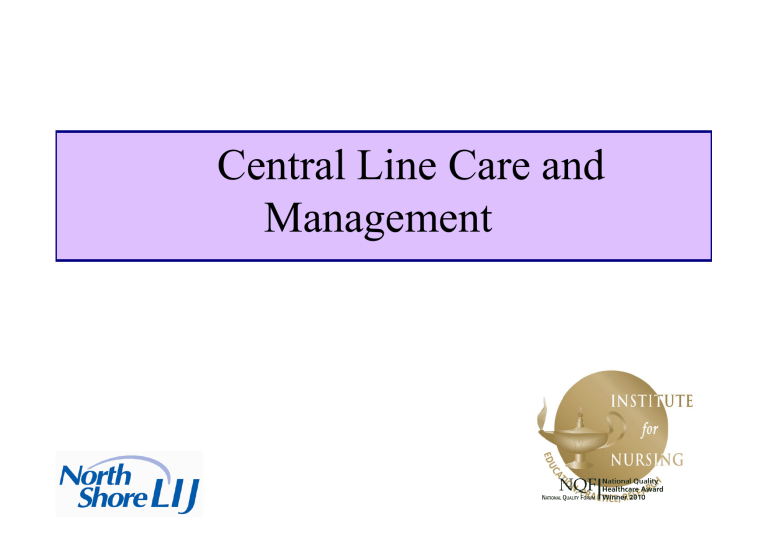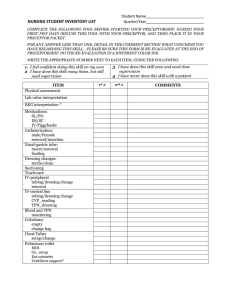Central Line Care and Management

Central Line Care and
Management
e -Module Central Line Care and Management
What is a Central Line/ CVAD?
(central venous access device)
• A vascular infusion device that terminates at or close to the heart or in one of the great vessels
(aorta, pulmonary artery, superior vena cava, inferior vena cava, brachiocephalic veins, internal jugular veins, subclavian veins, external iliac veins, and common femoral veins )
2
e -Module Central Line Care and Management
Indications for Central Lines
• To administer intravenous medications and intravenous fluids
• To obtain blood specimens
• To administer total parenteral nutrition or chemotherapy
• To transfuse blood/blood products
3
e -Module Central Line Care and Management
Central Line
Associated complications
• Arterial puncture
• Hematoma
• Pneumothorax
• Catheter malposition
• Arrhythmias
• Air embolism
• Thrombosis
• Infection
• Catheter occlusion
4
e -Module Central Line Care and Management
Locations and Insertion type
Locations:
• Subclavian vein
• Internal jugular vein
• Femoral vein
Types:
•Tunneled:
•Groshong, Hickman,
Broviac
•Non tunneled
•Arrow triple lumen
(very common)
•Midline
•(for intermediate term therapies)
5
e -Module Central Line Care and Management
Types of central lines/ CVAD’s
Triple lumen catheter
• Multi lumen catheter composed of 3 lumens.
• Each lumen has a pigtail of a different color
• Intended for short term use
6
e -Module Central Line Care and Management
Types of central lines/ CVAD’s
Double lumen
BE CAREFUL! Do not confuse with a double lumen catheter!
• May be inserted exclusively for dialysis (permcath, VAScath)
7
e -Module Central Line Care and Management
Types of central lines/ CVAD’s
Lll
Single lumen catheter
Often seen when patients go home with indwelling central lines
8
e -Module Central Line Care and Management
Types of central lines/ CVAD’s
Mediport/ Infusaport
A surgically implanted device placed subcutaneously under the skin. The ports are not externally exposed, so they are cosmetically appealing and have a lower risk of infection
BE CAREFUL!
Distinguish against Pacemaker
9
e -Module Central Line Care and Management
Peripherally Inserted Central Catheter
Percutaneous, single or multi-lumen line inserted in the arm.
(via the antecubital,basilic or cephalic or median cubital vein)
The tip of the PICC is placed in the superior vena cava at the entrance to the right atrium of the heart.
Duration: 1-12wks
BE CAREFUL –distinguish from a Peripheral IV !
10
e -Module Central Line Care and Management
Infusaport/Mediport and PICC Lines
• Must be accessed by specially trained personnel
• DO NOT ACCESS or DEACCESS INFUSAPORTS OR PICC
LINES UNLESS YOU HAVE ADDITIONAL PICC
TRAINING – BEYOND THIS MODULE!!
• You may hang a piggyback to pre-established main lines
• Maintain strict aseptic technique always
*Infusaport: uses a Huber Needle for accessing, so tubing will be connected to that.
11
e -Module Central Line Care and Management
Central Line Policies
• Sterile gloves, gowns, masks and caps must be worn for all central line insertions.
• All fluids/medication infused via central lines must be on a pump.
• IV tubing is connected with a threaded lock cannula
(needleless system).
12
e -Module Central Line Care and Management
Central Line Policies
• All medication must be piggy backed through a main line.
• Central line placement must be confirmed and documented before the line is accessed.
13
e -Module Central Line Care and Management
Central Line Policies
Introducers are not to be used outside of the ICU’s!
14
e -Module Central Line Care and Management
Central Line Policies
•
TPN and blood can be infused at the same time through CVCs that have staggered openings in each lumen or side-by-side lumens.
–
The double and triple CVC lumens are staggered.
–
Implanted ports and PICCs are side-by-side
15
e -Module Central Line Care and Management
Central Lines
• Insertion
• Accessing
(may require order)
• Deaccessing
(may require order)
• Drawing blood
• Dressing change with Clave (cap) change
16
e -Module Central Line Care and Management
Insertion
•
Utilize both the Central Line Insertion Care Team
Checklist and the CVC Insertion Note
•
Both must be filled out and signed by person who performed the procedure and the RN who witnessed the time-out procedure.
CLABS prevention measures:
•
The Central Line Insertion Care Team Checklist :
– is not part of the medical record
–
Use it to ensure and document compliance with Infection
Control guidelines (ie. sterile technique) and with Safety
Practices (ie. the guidewire was removed).
•
CVC insertion is to be observed by an RN who has received appropriate education to ensure that sterile technique, as indicated on the checklist, is followed.
17
e -Module Central Line Care and Management
Accessing Central Lines
• ID pt/ Explain procedure/ Prepare equipment/ clean injection site with alcohol
• With 10 ml saline syringe, aspirate for blood return
• Inject appropriate amount of saline/remove syringe applying positive pressure on plunger as syringe removed
• Connect IV infusion/ utilize infusion pump
• Remove gloves/ wash hands
• Document
18
e -Module Central Line Care and Management
Deaccessing Central Lines
• Done after accessing / infusing med
•
All unused (capped) central line catheters (subclavian, jugular or femoral) are flushed once every 12 hours with
10ml sterile 0.9% sodium chloride, and documented on the
MAR.
–
Note: only if ordered shall 1 ml heparin in a prefilled syringe (not to exceed 100 units/ml) be instilled after the saline flush .
• Inject appropriate amount of saline; remove syringe.
• Clamp tubing
•
Document in MAR.
Note:
•
Tunneled catheters Hickman /Broviac) require a flush every 12 hours if capped, with a 10 ml sterile prefilled 0.9 % sodium chloride syringe.
•
If patient
’ s therapy has ended or patient will be discharged, instill heparin 3 ml (not to exceed 100 units/ml) after the saline flush. Ensure documentation in the MAR.
19
e -Module Central Line Care and Management
Blood Draw
• ID pt/ Explain procedure/ Prepare equipment/clean injection site with alcohol
• Insert syringe into clave
• Discard appropriate amount of blood
• Draw required blood specimens in the order of the draw, using vacutainer
• Invert tubes 8- 10 x & label tubes at bedside
• Flush line with 20 ml of saline**
• Send specimens to lab in biohazard bag with requisition slip
• Document
**Note: only if ordered shall 1 ml heparin in a prefilled syringe (not to exceed 100 units/ml) be instilled after the saline flush .
Click here to watch a brief generic video on drawing blood from a central line http://vimeo.com/4757401
20
e -Module Central Line Care and Management
Follow this Order of the Draw when drawing multiple tubes
1. Blood Culture Bottles*
2. Blue*
3. Red
4. Gold
5. Green
6. Pink
7. Lavender
8. Gray
9. Other
21
e -Module Central Line Care and Management
Note
• Do not draw blood cultures (unless specifically requested by order)
• Be mindful about drawing coagulation studies
(blue tops) from the central line.
• Why?
22
e -Module Central Line Care and Management
Answer:
• Blood cultures should be drawn from peripheral site. You do not want blood from the line, unless you are trying to rule out line sepsis. You want a fresh specimen, not a specimen that’s been dwelling in the central line
– When you are drawing blood cultures from the line to rule out line sepsis, make sure to cleanse Clave port with
Chlora-Prep applicator
• Blue tops are coagulation studies and if the central line is heparinized, this may produce false results
23
e -Module Central Line Care and Management
Clave port Change and Tubing Change
• Capped central lines
– Clave port is changed once a week with dressing change.
– Approved device is the MicroClave.
– This device is cleaned prior to connection with IV tubing or a syringe with 2 alcohol prep pads – using friction and allowing to air dry!
IV Tubing connected to central lines. Change:
• for continuous infusion every 96 hours unless it is contaminated.
• for intermittent infusions, every 24 hours.
• Every 4 hours or with every unit of blood or blood products
• Every 12 hours with lipid based medications, Diprivan
• Every 24 hours with TPN and lipids alone
• Clave adapters are changed with tubing
• Click here to watch a brief generic video on drawing blood from a central line and performing a cap change: http://www.youtube.com/watch?v=dnjocVosQaQ
24
e -Module Central Line Care and Management
Dressing Change
• Best practice recommendations are for site care and dressing changes every 7 days and prn.
–
If gauze is present under the dressing, dressing must be changed every 48 hours
• Use sterile technique
• Use central line dressing change kit
• Do not touch PICC or infusaport dressings!
Click here to watch a brief generic video on central line dressing change: http://www.youtube.com/watch?v=t9lDv0204XQ
25
e -Module Central Line Care and Management
Writing your note
• Documentation findings
– Visual inspection description
– Palpated for tenderness
– Febrile? – blood cultures done?
– Drainage? – describe it; site/ blood culture done?
• Daily assessment of site
• Is the line patent?
• Presence or absence of blood return
• Accessing or deaccessing of line
• Document flush on Medication Administration Record
26
e -Module Central Line Care and Management
Return Demonstration
Return Demonstration will be done in orientation on:
• Accessing/ de-accessing a central line
• Drawing blood from a central line
• Central line dressing change with cap change
e -Module Central Line Care and Management
You have completed this module.
28





